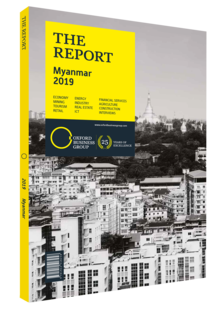Myanmar monetary policy must improve to prevent inflation
Currency depreciation continues to challenge macroeconomic growth in Myanmar, with the kyat losing more than 65% of its value against the US dollar between 2014 and 2018, straining import-dependent manufacturers and causing inflation to spike. More recently, the kyat lost 18% of its value against the US dollar between April and August 2018.
The Myanmar Sustainable Development Plan (MSDP), a detailed economic development agenda covering the period between 2018 and 2030, identifies currency volatility as a major impediment to growth in exports, foreign direct investment (FDI) and the overall economy. The development plan attributes the depreciation of the kyat both to global factors, such as the tightening of US monetary policy, and domestic causes, such as double-digit inflation since 2015, the slippage of FDI from a high of $9.4bn in FY 2015/16 to $5.7bn in FY 2017/18 and an unfavourable external balance of payments.
Over the medium term the MSDP proposes more effective management of both exchange rates and trade balances with major partners as stabilisation strategies. However, limited foreign exchange (forex) reserves, a rising import bill and reductions in approved FDI flows are likely to keep the exchange rate volatile in FY 2018/19.
Ongoing Volatility
Although the kyat’s depreciation might be expected to increase the competitiveness of its exports, the benefits to export producers have been limited as most manufacturing in Myanmar is dependent on raw commodity imports. Indeed, while the trade deficit as a share of GDP shrank in FY 2017/18, the Ministry of Commerce reported that between April and July 2018 the $6bn import bill exceeded the value of imports by $1.2bn.Weakening FDI inflows have also exacerbated the forex shortage and pushed inflation to new highs (see Trade & Investment chapter). Fuel prices rose from a range between MMK865 ($0.61) and MMK880 ($0.62) per litre in July 2018 to a range between MMK980 ($0.69) and MMK995 ($0.70) per litre as of mid-September 2018. More broadly, the World Bank reported that inflation jumped from 5.9% in April 2018 to 8.2% in August that year, driven by higher import costs, especially of rice and cooking oil, and projects that inflation will average 8.8% in FY 2018/19.
New Interventions
Promisingly for stakeholders, the Central Bank of Myanmar (CBM) and government have responded to rising inflation and currency volatility with a large number of MSDP-recommended interventions. Among these, for example, the MSDP suggested that the central bank allow the kyat to float more freely in response to market supply and demand, and ensure greater exchange rate flexibility as the bank moves from a foreign exchange auction to an interbank transaction-based mechanism for setting the exchange rate.
In mid-August 2018 the CBM announced that private banks and exchange counters would no longer be required to trade within a previous limit of 0.8% of its official exchange rate band, in an effort to reduce price manipulation and reduce volatility. Following the decision, the kyat improved from 1524 to the US dollar on August 17, 2018 to 1488.9 on August 18, 2018, although it continued to depreciate in the following weeks, hitting a high of 1627.9 to the US dollar on September 23, 2018.
In late October 2018 local media reported that the kyat had depreciated by around 25% against the US dollar, with inflation hitting 8.5% in the same month, up from 5.5% in October 2017. Local press praised the CBM for allowing a de facto float against the dollar, in addition to other recent policy measures including removing trading bands and halting the re-export of oil and sugar to China – a major draw on forex reserves. As of early November 2018, the kyat was trading at around 1600 to the dollar, compared to around 1360 the same period in the previous year.
You have reached the limit of premium articles you can view for free.
Choose from the options below to purchase print or digital editions of our Reports. You can also purchase a website subscription giving you unlimited access to all of our Reports online for 12 months.
If you have already purchased this Report or have a website subscription, please login to continue.

